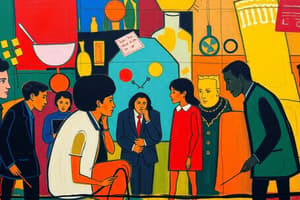Podcast
Questions and Answers
What was attributed to the rise in delinquency in Chicago according to Shaw and McKay?
What was attributed to the rise in delinquency in Chicago according to Shaw and McKay?
- Neighborhood characteristics (correct)
- Increased law enforcement
- Poor economic conditions
- High population density
Social disorganization theory suggests that population characteristics influence crime rates.
Social disorganization theory suggests that population characteristics influence crime rates.
True (A)
What common link does social disorganization theory have with positivist theory?
What common link does social disorganization theory have with positivist theory?
Both theories consider the environment to be primarily responsible for criminal behavior.
What are the causal factors of social disorganization theory?
What are the causal factors of social disorganization theory?
What is the concentric zone model?
What is the concentric zone model?
Which factor leads to higher crime rates according to Shaw and McKay's observations?
Which factor leads to higher crime rates according to Shaw and McKay's observations?
The social disorganization theory argues that the inability of institutions to control the behavior of youths results in _____.
The social disorganization theory argues that the inability of institutions to control the behavior of youths results in _____.
Residents in transition areas have developed strong social bonds.
Residents in transition areas have developed strong social bonds.
Flashcards are hidden until you start studying
Study Notes
Focus of Social Disorganization Theory
- Rapid social changes in early 1900s Chicago led to rising delinquency amidst modernization and industrialization.
- Shaw and McKay analyzed delinquency data linked to residential addresses, finding crime concentration in specific neighborhoods.
- Neighborhood conditions, rather than individual characteristics, directly contributed to crime rates.
- High residential mobility creates unstable social ties, leading to social disorganization, defined by weakened institutions like families and schools.
- The breakdown of these institutions fails to control youth behavior, resulting in increased crime.
Common Link with Positivist Theory
- Social disorganization theory aligns with positivist theory, which claims individuals with certain physiological traits predispose them to criminal behavior.
- Modern positivist criminologists recognize that both biological traits and social conditions influence criminal behavior.
- Environmental factors like poverty may amplify the likelihood of crime in individuals with predispositions, such as lower IQ in disadvantaged settings.
- Both theories emphasize societal influence on delinquency, attributing it to social conditions rather than individual choices.
Causal Factors of Social Disorganization Theory
- Key causal factors leading to crime include:
- Ethnic heterogeneity
- Breakdown of social control
- Cultural transmission of delinquent behavior
Ethnic Heterogeneity
- Shaw and McKay's research focused on rapidly developing urban areas, applying Burgess's concentric zone model.
- Highest crime rates were found in transitional zones close to business areas, where economically disadvantaged, ethnically diverse populations reside.
- New residents replace those who can afford better living conditions, leading to persistent poverty and racial discrimination in these neighborhoods.
- Economic deprivation contributes to elevated crime rates in areas marked by high racial heterogeneity.
Concentric Zone Model
- The model posits cities expand outward from a central business district, dividing into distinct zones.
- The zone of transition exists just outside the business center, characterized by shifts in demographics and economic conditions.
Breakdown of Social Control
- Frequent movement in and out of transition areas hinders residents' ability to form relationships and cohesively integrate.
- Differing values and norms among diverse racial groups foster mistrust and reduce social bonding.
- The lack of established community ties contributes to ineffective social control and increases the likelihood of delinquency.
Studying That Suits You
Use AI to generate personalized quizzes and flashcards to suit your learning preferences.




